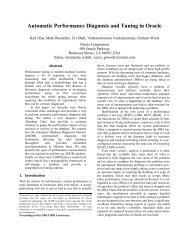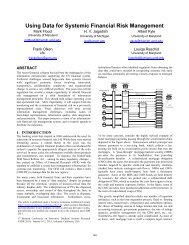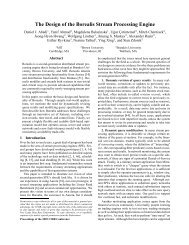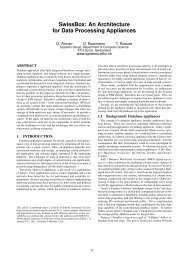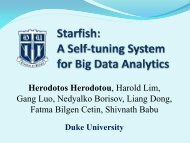Query Processing for Sensor Networks - CIDR
Query Processing for Sensor Networks - CIDR
Query Processing for Sensor Networks - CIDR
You also want an ePaper? Increase the reach of your titles
YUMPU automatically turns print PDFs into web optimized ePapers that Google loves.
Let us consider two different query plans <strong>for</strong> <strong>Query</strong><br />
Q3. In Plan 1, we use an existing flow block which<br />
covers the whole network. This flow block is also used<br />
to collect system catalog in<strong>for</strong>mation, thus it does not<br />
incur additional maintenance cost. In Plan 2, we construct<br />
a new flow block <strong>for</strong> <strong>Query</strong> Q3 just inside the<br />
query region, where we first compute the average at a<br />
leader of this block, and then send qualifying averages<br />
to the gateway node.<br />
Both plans may per<strong>for</strong>m the HAVING operation as a<br />
filter over the average value of the sensor reading, at<br />
the gateway <strong>for</strong> Plan 1, but the leader node in Plan 2.<br />
The result in Figure 11 shows that if the selectivity of<br />
the HAVING operator is close to 100% and thus the computation<br />
at the leader does not reduce the number of<br />
outgoing averages, then there is not much difference in<br />
terms of the average dissipated sensor energy <strong>for</strong> each<br />
round of the query. Plan 2 spends only a little more<br />
energy on maintenance of the additional flow block.<br />
However, as the leader discards aggregated data packets<br />
with higher and higher probability, Plan 2 is a much<br />
better choice. It reduces the traffic flow significantly<br />
through aggregation at the leader much closer to data<br />
sources, compared to the gateway node of Plan 1.<br />
Next, we evaluate different query plans <strong>for</strong> <strong>Query</strong><br />
Q1, a query with a GROUP BY clause. Assume that<br />
there are four different groups. Let us consider three<br />
simple cases: In the distributed case, sensors that below<br />
to a single group are physically close, but far away<br />
from other groups. In the close-by case, the groups are<br />
close to each other, but they do not overlap, whereas<br />
in the overlap scenario, all four groups are in the same<br />
area. We again consider two different query plans <strong>for</strong><br />
this query. Plan 1 creates one big cluster to be shared<br />
by all groups. Aggregation within each group happens<br />
at the global cluster leader. Plan 2 creates a separate<br />
cluster <strong>for</strong> each group, and aggregates only the tuples<br />
relevant <strong>for</strong> each group at the respective cluster leader.<br />
Figure 16 shows the different spatial distributions of<br />
the four groups <strong>for</strong> the three cases.<br />
We can see from Figure 12 that if the groups are<br />
physically close, then there is no big difference between<br />
Plans 1 and 2. However, creating one big cluster<br />
increases the connectivity of the cluster, and reduces<br />
the risk of network partitioning within a cluster. If<br />
the four groups are spatially distant from each other,<br />
Plan 2 is more efficient as the selection at the aggregation<br />
leaders can reduce the number of data packets<br />
<strong>for</strong> transmission back to the gateway node. In the last<br />
scenario, where the different groups of sensors are randomly<br />
distributed, Plan 1 outper<strong>for</strong>ms Plan 2, since<br />
the cost to collect data records at the leader is high.<br />
Figures 13 and 14 show the influence of operator<br />
selectivity on the two plans in the previous experiment<br />
<strong>for</strong> two different sensor topologies, the distributed<br />
topology in Figure 13 and the overlap topology<br />
in Figure 14. The experiment shows that operator<br />
selectivity has a strong influence on plan per<strong>for</strong>mance,<br />
although the sensor topology has a much larger impact.<br />
Next we consider the Join <strong>Query</strong> Q2. Again we<br />
consider two query plans to evaluate this query. In<br />
Plan 1, sensors send all tuples back to the gateway<br />
without any in-network computation; Plan 2 creates<br />
a flow block <strong>for</strong> the Join operator inside the query<br />
region. In Plan 2, in case the join reduces the data<br />
size at the leader, the leader sends the result of the<br />
join back to the gateway, otherwise, the leader sends<br />
all individual data records to the gateway <strong>for</strong> the join<br />
to be per<strong>for</strong>med there.<br />
Figure 15 shows that the cost to collect data at the<br />
leader is non-trivial. If the join operator at the leader<br />
fails to reduce the data size, then the total energy consumption<br />
at the node increases. Thus the optimizer<br />
needs to estimate the selectivity of the join operator,<br />
and it needs statistics in the systems catalog to make<br />
the right decision.<br />
7 Related Work<br />
Research of routing in ad-hoc wireless networks has<br />
a long history [17, 30], and a plethora of papers has<br />
been published on routing protocols <strong>for</strong> ad-hoc mobile<br />
wireless networks [25, 16, 5, 26, 24, 8, 15]. All these<br />
routing protocols are general routing protocols and do<br />
not take specific application workloads into account,<br />
although we believe that most of these protocols can<br />
be augmented with the techniques similar to those that<br />
we propose in Section 4. The SCADDS project at USC<br />
and ISI explores scalable coordination architectures <strong>for</strong><br />
sensor networks [9], and their data-centric routing algorithm<br />
called directed diffusion [14] first introduced<br />
the notion of filters that we advocate in Section 4.2.<br />
There has been a lot of work on query processing<br />
in distributed database systems [40, 7, 23, 39, 18], but<br />
as discussed in Section 1, there are major differences<br />
between sensor networks and traditional distributed<br />
database systems. Most related is work on distributed<br />
aggregation, but existing approaches do not consider<br />
the physical limitations of sensor networks [33, 38].<br />
Aggregate operators are classified by their properties<br />
by Gray et al. [10], and an extended classification with<br />
properties relevant to sensor network aggregation has<br />
been proposed by Madden et al. [21].<br />
The TinyDB Project at Berkeley also investigates<br />
query processing techniques <strong>for</strong> sensor networks including<br />
an implementation of the system on the Berkeley<br />
motes and aggregation queries [19, 20, 21, 22].<br />
Other relevant areas include work on sequence<br />
query processing [31, 32], and temporal and spatial<br />
databases [41].



